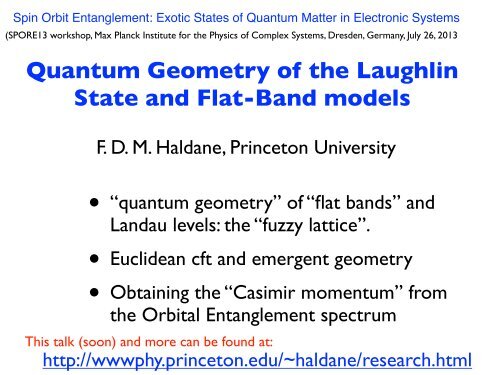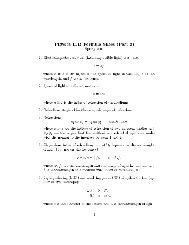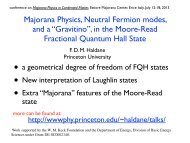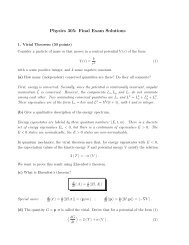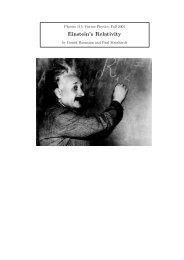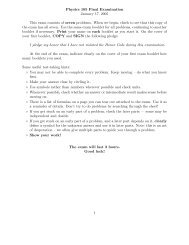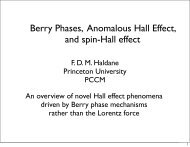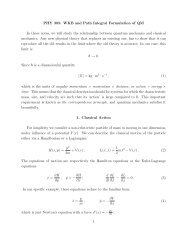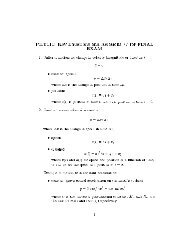Quantum Geometry of the Laughlin State and Flat-Band models
Quantum Geometry of the Laughlin State and Flat-Band models
Quantum Geometry of the Laughlin State and Flat-Band models
Create successful ePaper yourself
Turn your PDF publications into a flip-book with our unique Google optimized e-Paper software.
• “classical locality” means <strong>the</strong> existence <strong>of</strong> anorthogonal basis <strong>of</strong> coordinate eigenstates[ˆx a , ˆx b ]=0hx|x 0 i =0, x 6= x 0ˆx a |x 0 i = x 0a |x 0 i• This structure is required for <strong>the</strong> equivalence<strong>of</strong> <strong>the</strong> Schrödinger <strong>and</strong> Heisenbergformulations <strong>of</strong> quantum mechanics:(x) =hx| i• This equivalence fails for non-commuting coordinates•Projection into a “flat b<strong>and</strong>” leads to non-commutingcoordinates
• b<strong>and</strong> structure plus gauge-invariantinteractions:H = H 0 + V ({n i })n i = X c † i c iH 0 = Xi,j, 0t i ,j 0c † i c j 0= X nk" n (k)c † nk c nk• assume one or more “flat b<strong>and</strong>s”are present near <strong>the</strong> Fermi energy• Projection into <strong>the</strong>se b<strong>and</strong>s: P 0EFemptylarge gaplarge gapfilled
• basis with “classical locality” |x i, i = c † i |0ihx i , |x j ,0 i = ij 0• projected (<strong>and</strong> renormalized) basisP 0 |x i , i = i | 0 (x i , )i h 0 (x i , )| 0 (x i , )i =1projected into <strong>the</strong> “flat b<strong>and</strong>” renormalized to unit weight• “quantum geometry” is encoded in <strong>the</strong> overlaph 0 (x i , )| 0 (x j ,0 )i = S i ,j 0• renormalized states have a local gauge ambiguity under| 0 (x i , i)i 7! e i'(x i, ) | 0 (x i , i)i
• “quantum geometry” is encoded in <strong>the</strong> overlaph 0 (x i , )| 0 (x j ,0 )i = S i ,j 0• gauge-invariant “quantum distance”d 12 =(1 |S 12 |) 1 2obeys triangleinequalityThis is <strong>the</strong> “trivial distance” for orthonormal orbitals,where d = 0 (same), or d = 1 (different)• gauge-invariant “triangle Berry phases”S 12 S 23 S 31 = |S 12 S 23 S 31 |e i 123213
• after projection into <strong>the</strong> flat b<strong>and</strong>, one endsup with a model <strong>of</strong> <strong>the</strong> formH = U({n i })a modified gauge-invariant interactionpotential, because <strong>of</strong> <strong>the</strong> renormalizationsn i = X c † ic ic i c † j 0 ± c † j 0 c i = S i ,j 0• The Hermitian matrix S is positive indefinite(has null modes) because <strong>the</strong>re are moreorbitals per unit cell than “flat b<strong>and</strong>s”
• Spin-orbit coupling makes <strong>the</strong> “quantumgeometry” richer, but for simplicity, I willnow drop <strong>the</strong> spin-degree <strong>of</strong> freedom• Consider <strong>the</strong> (spinless) boson “flat b<strong>and</strong>”Hubbard model on <strong>the</strong> “fuzzy lattice”H = 1 2XiU i c † i c† i c ic i[c i ,c † j ]=S ijc † i ⌘ c† R,↵ U i = U ↵d ij = d ↵↵ 0(R R 0 )unit cell<strong>of</strong> Bravaislatticebasis <strong>of</strong>orbitals withinunit cell“fuzzy lattice” quantum distances<strong>and</strong> triangle Berry phases areinvariant under lattice translationsnon-null eigenstates <strong>of</strong> S ij are Bloch b<strong>and</strong>s whichencode <strong>the</strong> flat-b<strong>and</strong> topological invariants
• A L<strong>and</strong>au level is a “flat b<strong>and</strong>” with acontinuous translation symmetry, <strong>and</strong> <strong>the</strong> ν= 1/2 <strong>Laughlin</strong> state is <strong>the</strong> maximumdensityzero-energy ground state <strong>of</strong>H = 1 2 U Zd 2 x2⇡`2B[c(x),c † (x 0 )] = S(x, x 0 )z = ! ax ap 2`Ba complexunit vectorc † (x)c † (x)c(x)c(x)= e z⇤ z 0 e 1 2 z⇤z e 1 2 z0⇤ z 0! ⇤ a! b = 1 2 (g ab + i✏ ab )2d metric with Euclideansignature, detg = 1.The metric g ab is <strong>the</strong> fundamental parameter<strong>of</strong> model wavefunctions based on Euclidean cft!2d antisymmetricsymbol
• If <strong>the</strong> integral over x is discretized in anyperiodic pattern <strong>of</strong> points {x i } that has oneflux quantum per unit cell, <strong>the</strong> Chernnumber <strong>of</strong> <strong>the</strong> single non-null b<strong>and</strong> <strong>of</strong> Blocheigenstates <strong>of</strong> S ij is 1.• There are two independent two-body statesc † (x)c † (x)|0> per flux quantum, so at leasttwo discretization points per unit cell areneeded to reproduce <strong>the</strong> count <strong>of</strong> non-nulltwo-body states.• This discretization will reproduce <strong>the</strong> zeroenergystate count <strong>of</strong> <strong>the</strong> continuum model.
• Thus <strong>the</strong> continuum 1/2 <strong>Laughlin</strong> state willalso be <strong>the</strong> zero-energy ground state <strong>of</strong> a“Fuzzy-Lattice” flat-b<strong>and</strong> honeycomb netboson Hubbard model with Chern number1, if <strong>the</strong> projected orbitals on each site aretaken to be L<strong>and</strong>au-level guiding-centerGaussian coherent states.H = 1 2 U X xc † (x)c † (x)c(x)c(x)Two orbitals, one fluxquantum, per unit cell• A “real” fuzzy-lattice Hubbard model obtainedfrom a projected flat-b<strong>and</strong> structure willexhibit a <strong>Laughlin</strong>-like ground state if itsoverlap function is “sufficiently close” to <strong>the</strong>Gaussian one
some related “mysteries”• Why are model wavefunctions related to(Euclidean) 2+0 d cft good <strong>models</strong> for <strong>the</strong>FQHE?• If <strong>the</strong> <strong>Laughlin</strong> state is a “lowest L<strong>and</strong>au levelSchroedinger wavefunction” why does itoccur in <strong>the</strong> second L<strong>and</strong>au level?• Why is it “holomorphic”?•What aspects <strong>of</strong> 1+1d cft apply to edgestates?
• The conformal group is <strong>the</strong> group <strong>of</strong>coordinate transformations that preserve<strong>the</strong> unimodular part <strong>of</strong> a metricds 2 = e 2'(x,t) v 1 dx 2 vdt 2(1+1)d“universal speed <strong>of</strong> massless particles”ds 2 = e 2'(x)g ab dx a dx b(2+0)d“Euclidean metric, det g = 1”
• after L<strong>and</strong>au quantization, residual guiding center degrees <strong>of</strong>freedom are non-commutativer = R + ˜R[R a ,R b ]= i`2B✏ abeliminatedby L<strong>and</strong>auquantizationantisymmetricsymbol• isomorphic to phase space, <strong>the</strong>yobey an uncertainty principleclassicalcoordinateOrRL<strong>and</strong>au orbitradius vectore⇥˜Rguiding centercoordinateguiding centerscannot be localizedwithin an area lessthan 2⇡`2B
• The metric defines <strong>the</strong> shape <strong>of</strong> <strong>the</strong> coherent state at <strong>the</strong> center<strong>of</strong> <strong>the</strong> “symmetric gauge” basis <strong>of</strong> guiding-center statesdifferent choices <strong>of</strong> metric:(“squeezed” relative to each o<strong>the</strong>r)centralcoherentstate| 0 (g)i• Guiding-center “spin” (rotationoperator) is defined by <strong>the</strong> metricL(g) = g ab2`2BR a R b[L(g),a † (g)] = a † (g)a(g)| 0 (g)i =0| m (g)i = (a† (g)) mp m!| 0 (g)i
• Model cft-based states such as <strong>the</strong> <strong>Laughlin</strong> statehave a constant (flat, rigidly-fixed) metric• In real FQH states <strong>of</strong> electrons contained in anon-uniform background potential, <strong>the</strong> metricvaries locally <strong>and</strong> dynamically to allow <strong>the</strong>incompressible fluid to adjust to non-uniformflow induced by <strong>the</strong> background.• The metricg ab (r,t) <strong>the</strong>n becomes an emergentdynamical collective degree <strong>of</strong> freedom <strong>of</strong> <strong>the</strong>FQH state.FDMH, Phys. Rev. Lett. 107, 116801 (2011)
holomorphicity:• coherent state basisā|¯zi =¯z|¯zi |¯zi = e¯zā†¯z ⇤ā|0iS(¯z, ¯z ⇤ ;¯z 0 , ¯z ⇤ )=h¯z|¯z 0 i = e¯z⇤ ¯z 01 2 (¯z0⇤ ¯z 0 +¯z ⇤ ¯z)• non-null eigenstates <strong>of</strong> <strong>the</strong> overlap define anorthonormal basisZ d¯z 0 d¯z 0⇤2⇡ S(¯z, ¯z⇤ ;¯z 0 , ¯z 0⇤ ) (¯z 0 , ¯z 0⇤ )= (¯z, ¯z ⇤ )• non-null eigenstates are degenerate with λ = 1(¯z, ¯z ⇤ )=f(¯z ⇤ )e 1 2 ¯z⇤ ¯zholomorphic!“accidentally” coincidewith lowest-L<strong>and</strong>au levelwavefunctions if ¯z = z ⇤ !!!
• This is <strong>the</strong> true origin <strong>of</strong> holomorphicfunctions in <strong>the</strong> <strong>the</strong>ory <strong>of</strong> <strong>the</strong> FQHE• NOTHING to do with lowest L<strong>and</strong>au levelstates, derives from overlaps between statesin a non-orthogonal overcomplete basis!• Has obvious parallels in <strong>the</strong>ory <strong>of</strong> flat-b<strong>and</strong>Chern insulators, where <strong>the</strong> projected latticesitebasis is non-orthogonal <strong>and</strong> overcomplete|qL i = Y iZ d¯z⇤i d¯z i2⇡“<strong>Laughlin</strong>wavefunction”Yi
• It is a common misconception that <strong>the</strong> <strong>Laughlin</strong>state is fundamentally “a lowest L<strong>and</strong>au-levelwavefunction” <strong>of</strong> Galileian-invariant L<strong>and</strong>au levels• The similarity to a lowest-LL wavefunction is entirelyaccidental, as should have been clear when it wasalso found in <strong>the</strong> second LL. The recent discoverythat <strong>Laughlin</strong>-like states occur in “flat b<strong>and</strong>” Cherninsulators now makes this entirely clear!• The holomorphic character <strong>of</strong> <strong>the</strong> <strong>Laughlin</strong> state isentirely a property <strong>of</strong> <strong>the</strong> “quantum geometry” <strong>of</strong> <strong>the</strong>flat b<strong>and</strong> (L<strong>and</strong>au level) encoded in s(r 1 ,r 2 ), which inturn depends on <strong>the</strong> choice <strong>of</strong> metric g ab .
• Origin <strong>of</strong> FQHE incompressibility is analogous toorigin <strong>of</strong> Mott-Hubbard gap in lattice systems.• There is an energy gap for putting an extra particlein a quantized region that is already occupied• On <strong>the</strong> lattice <strong>the</strong> “quantizedregion” is an atomic orbital witha fixed shape• In <strong>the</strong> FQHE only <strong>the</strong> area <strong>of</strong><strong>the</strong> “quantized region” is fixed.The shape must adjust tominimize <strong>the</strong> correlation energy.e - energy gap preventsadditional electronsfrom entering <strong>the</strong>region covered by <strong>the</strong>composite boson
• The metric (shape <strong>of</strong> <strong>the</strong> composite boson) has apreferred shape that minimizes <strong>the</strong> correlationenergy, but fluctuates around that shape• The zero-point fluctuations <strong>of</strong> <strong>the</strong> metric are seenas <strong>the</strong> O(q 4 ) behavior <strong>of</strong> <strong>the</strong> “guiding-centerstructure factor” (Girvin et al, (GMP), 1985)E / (distortion) 2• long-wavelength limit <strong>of</strong> GMP collective mode isfluctuations <strong>of</strong> (spatial) metric (analog <strong>of</strong> “graviton”)FDMH, Phys. Rev. Lett. 107, 116801 (2011)
1/3 <strong>Laughlin</strong> state If <strong>the</strong> central orbital is filled,<strong>the</strong> next two are emptyeThe composite bosonhas inversion symmetryabout its centerIt has a “spin”<strong>the</strong> electron excludes o<strong>the</strong>r particles froma region containing 3 flux quanta, creating apotential well in which it is bound−121 0 01332135213..........L = 1 2− L = 3 2s = 1
• crucial new physics:composite bosons couple to <strong>the</strong> combinationpeB(r)charge <strong>of</strong> compositeboson* gauge field isrelated toWen <strong>and</strong> Zee 1992~sK(r)guiding-center“spin” <strong>of</strong> bosonpeA µ (r)Gaussian curvature<strong>of</strong> metric~s⌦ µ (r)analog <strong>of</strong> spin-connection+ Chern-Simons
• metric deforms (preserving det g =1)inpresence <strong>of</strong> non-uniform electric fieldfluidcompressedby Gaussiancurvature!potentialnear edgeproduces a dipole momemt
• multicomponent quantum Hall edge statesdo not have a universal speed, so are notLorentz <strong>and</strong> conformally invariant.• components <strong>of</strong> <strong>the</strong> cft energy momentumtensor:Momentum density is independent <strong>of</strong> v:T 0 x = T¯TEnergy density <strong>and</strong> stress are proportional to vT 0 0 = T x x = v(T + ¯T )Tracelessness (in flat space-time) is independent <strong>of</strong> vT 0 0 + T x x =0Energy current density is proportional to v 2T x 0 = v 2 (T ¯T )
The only speed-independent properties are• The (signed) Virasoro algebra <strong>of</strong> <strong>the</strong> Fouriercomponents <strong>of</strong> <strong>the</strong> momentum density (with <strong>the</strong>topologically-conserved chiral central charge˜c = cThis is a fundamental quantity that has nothing todo with conformal invariance (<strong>and</strong> in fact mustvanish in a “true” (modular-invariant) 1+1d cft )It controls a “Casimir momentum” 124 ~˜c/L• Tracelessness <strong>of</strong> <strong>the</strong> energy-momentum tensor (1dpressure = energy density), which is true for linearlydispersingmodes, independent <strong>of</strong> <strong>the</strong>ir speed.¯c
• Tracelessness <strong>of</strong> <strong>the</strong> 2D stress tensor in <strong>the</strong>Euclidean field <strong>the</strong>ory is <strong>the</strong> absence <strong>of</strong>hydrostatic 2D pressureP = 1 2 T x x + T y y =0• Incompressible 2D quantum fluids at T = 0 donot transmit pressure through <strong>the</strong>ir bulkbecause <strong>of</strong> <strong>the</strong>ir energy gap (no gapless soundmodes) - <strong>the</strong>y only transmit pressure around<strong>the</strong>ir edges via gapless edge excitations.• The traceless stress tensor <strong>of</strong> Euclidean 2dconformal field <strong>the</strong>ory (<strong>and</strong> its dependence ona metric) may explain its applicability to FQHE
One final result• In <strong>the</strong> “trivial” non-topologically-orderedinteger QHE (due to <strong>the</strong> Pauli principle)˜c = ⌫ =Chernnumber˜c ⌫ =0• <strong>the</strong> (guiding-center) “orbital entanglementspectrum” <strong>of</strong> Li <strong>and</strong> Haldane is insensitive t<strong>of</strong>illed (or empty) L<strong>and</strong>au levels or b<strong>and</strong>s, <strong>and</strong>allows direct determination <strong>of</strong> non-zero ˜cprevious methods used <strong>the</strong> onerous calculation <strong>of</strong><strong>the</strong>“real-space” entanglement spectrum to find ˜c⌫
140"laughlin3_n_13.cyl16.14" using 2:4ORBITAL CUT120100806040200• Hall viscosity gives “<strong>the</strong>rmally excited”momentum density on entanglement cut,relative to “vacuum”, at von Neumanntemperature T = 10 5 10 15 20 25 30 35 40signed conformalanomaly (chiral stressenergyanomaly)“CASIMIR MOMENTUM” term(NOT “real-space cut” which requires<strong>the</strong> L<strong>and</strong>au orbit degrees <strong>of</strong> freedom <strong>and</strong> <strong>the</strong>irform factor to be includedchiralanomalyvirasoro level<strong>of</strong> sector
Yeje Park, Z Papic, N Regnault124 (˜c ⌫) = 1 24 1 1= 1336mean Virasoro level - expected0.10.080.060.040.020-0.02-0.04-0.06L_A = 148, plevel = 12, +1/6L_A = 149, plevel = 12L_A = 150, plevel = 12, +1/6L_A = 149, plevel = 111/361360 100 200 300 400 500 600 700 800 900L^2Matrix-product state calculation on cylinder with circumference L(“plevel” is Virasoro level at which <strong>the</strong> auxialliary space is truncated)


